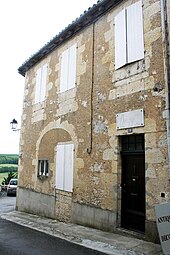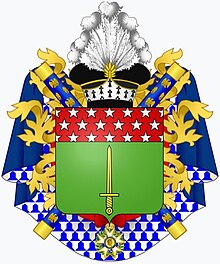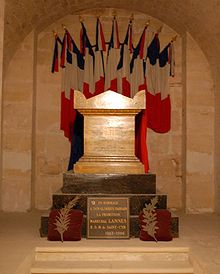Jean Lannes
Jean Lannes Duke of Montebello,Prince ofSiewierz | |
|---|---|
 Lannes in the uniform of colonel of theSwiss,byJean-Charles Nicaise Perrin(between 1805–1810) | |
| Nickname(s) | Rolandof theGrande Armée,Achillesof theGrande Armée |
| Born | 10 April 1769 Lectoure,Guyenne-Gascony,Kingdom of France |
| Died | 31 May 1809(aged 40) Ebersdorf,Lower Austria,Austria |
| Buried | |
| Allegiance | |
| Service/ | Army |
| Years of service | 1792–1809 |
| Rank | Marshal of the Empire |
| Battles/wars | |
| Awards | Grand Cross of theLegion of Honour Commander of theOrder of the Iron Crown Duke of the Empire[1] |
| Spouse(s) | |
| Relations | Gustave Olivier Lannes de Montebello(son) |
| Signature | |
Jean Lannes,1stDuke of Montebello,Prince ofSiewierz(French pronunciation:[ʒɑ̃lan];10 April 1769 – 31 May 1809), was aFrenchmilitary commander and aMarshal of the Empirewho served during both theFrench RevolutionaryandNapoleonic Wars.
He was one ofNapoleon's most daring and talented generals, and is regarded by many as one of history's greatest military commanders. Napoleon once commented on Lannes: "I found him apygmyand left him agiant".[2]A personal friend of the emperor,[3]he was allowed to address him with the familiartu,as opposed to the formalvous.
Early life[edit]

Lannes was born in the small town ofLectoure,[2][4]in the province ofGasconyin Southern France. He was the son of a small landowner and merchant, Jeannet Lannes (1733–1812), son of Jean Lannes (d. 1746), a farmer, and his wife, Jeanne Pomiès (d. 1770), and paternal grandson of Pierre Lane and wife Bernarde Escossio (both died in 1721), and wife Cécile Fouraignan (1741–1799), daughter of Bernard Fouraignan and wife Jeanne Marguerite Laconstère. He was apprenticed in his teens to adyer.[2][4]Lannes received little education, but his great strength and proficiency in many sports caused him in 1792 to be elected sergeant-major of the battalion of volunteers of Gers, which he had joined upon the outbreak of war between France and Spain. He served under GeneralJean-Antoine Marbotduring the campaigns in the Pyrenees in 1793 and 1794, and rose by distinguished conduct to the rank ofchef de brigade.During his time in the Pyrenees, Lannes was given some important tasks by GeneralJacques François Dugommierand recommended for promotion by future MarshalLouis-Nicolas Davout.[5]
Campaigns of Italy and Egypt[edit]


Lannes served under GeneralBarthélemy Louis Joseph Schérer,taking part in theBattle of Loano.[5]However, in 1795, as a result of the reforms of the army introduced by theThermidorians,he was dismissed from his rank.[6]He re-enlisted as a simple volunteer in the FrenchArmée d'Italie.[citation needed]He served in the Italian campaign of 1796, and climbed his way up to high rank once again,[citation needed]being given command of a brigade in GeneralPierre Augereau’s division[7]and later of 3 battalions of the permanent advance guard at different times.[8]Lannes was distinguished in every battle and played an important role in thevictory at Dego.[8]At theBattle of Bassano,he captured two enemy flags with his own hands[8]and received multiple wounds at theBattle of Arcolebut kept leading his column in person.[9]
Lannes led troops underClaude Victor-Perrinin the invasion of thePapal States.[9]When he and a small reconnaissance party ran into 300 Papal cavalry, he averted danger by astutely ordering the men to return to base, convincing them not to attack.[7][9]
He was chosen by Bonaparte toaccompany him to Egyptas commander in one of GeneralJean-Baptiste Kléber's brigades,[10]in which capacity he greatly distinguished himself, especially during theretreat from Syria.Lannes was wounded at theBattle of Abukir,before he returned to France with Bonaparte, and assisted him in theCoup of 18 Brumaire.[7]After Bonaparte's takeover and appointment as Consul of France, Lannes was promoted to the ranks of general of division and commandant of theConsular Guard.
Back with theArmée d'Italie,Lannes commanded the advanced guard in the crossing of theAlpsin 1800, was instrumental in winning theBattle of Montebello,[11]from which he afterwards took his title, and played a large part in theBattle of Marengo.[6][12]
Napoleonic Wars[edit]


GeneralJoachim MuratandChef de brigadeJean-Baptiste Bessièresschemed to have Lannes removed over a budget deficit,[13]but Augereau bailed him out.[13]As a result, Lannes was not totally disgraced,[13]but was instead sent as ambassador to Portugal in 1801.[7][13]Opinions differ as to his merits in this capacity; Napoleon never made such use of him again. Lannes purchased the seventeenth-centuryChâteau de Maisons,near Paris, in 1804 and had one of its state apartments redecorated for a visit from Napoleon.
Upon the establishment of theFirst French Empire,he was made one of the original eighteenMarshals of the Empire.[14]In 1805, he fully regained Napoleon's favour,[14]which he lost during the consulate.[15]AtAusterlitz,he commanded the left wing of theGrande Armée.During theWar of the Fourth Coalition,Lannes was at his best, commanding his corps with the greatest credit in the march through theThuringianForest, theBattle of Saalfeld(which is studied as a model today at the French Staff College), and theBattle of Jena.His leadership of the advance guard atFriedlandwas even more prominent.[6]
In 1807, Napoleon recreated theDuchy of Siewierz(Sievers), granting it to Lannes afterPrussiawas forced to cede all her acquisitions from the second and thirdpartitions of Poland.
After this, Lannes was to be tested as a commander-in-chief, for Napoleon sent him to Spain in 1808 and gave him a detached wing of the army to command, with which he won a crushing victory over GeneralFrancisco CastañosatTudelaon 22 November. In January 1809, he was sent tocapture Zaragoza,and by 21 February, after one of the most stubborn defences in history, Lannes was in possession of the place. He later said, "this damned Bonaparte is going to get us all killed" after his last campaign in Spain.[citation needed]In 1808, Napoleon made himDuke of Montebello,and in 1809, for the last time, gave him command of the advance guard. He took part in the engagements around Eckmühl and the advance on Vienna. With his corps, he led the French Army across theDanube Riverand bore the brunt, with MarshalAndré Masséna,at theBattle of Aspern-Essling.[6]
Death[edit]

On 22 May 1809, during a lull in the second day of theBattle of Aspern-Essling,Lannes went and sat down at the edge of a ditch, his hand over his eyes and his legs crossed.
As he sat there, plunged in gloomy meditation on having seen his friend, GeneralPierre Charles Pouzet,decapitated mid-conversation by a cannonball, a second cannonball fired from a gun atEnzersdorfricocheted and struck him just where his legs crossed. The knee-pan of one was smashed, and the back sinews of the other torn. The marshal said, "I am wounded; it's nothing much; give me your hand to help me up." He tried to rise, but could not.
He was carried to thetête de pont,where the chief surgeons proceeded to dress his wound. One of Lannes' legs was amputated within two minutes byDominique Jean Larrey.He bore the painful operation with courage; it was hardly over when Napoleon came up and, kneeling beside the stretcher, wept as he embraced the marshal. On 23 May, he was transported by boat to the finest house inKaiserebersdorf,now a part ofSimmering districtof Vienna. Eight days later, Lannes succumbed to his painful wounds at daybreak, He died of his wounds on 31 May.
He was initially buried inLes Invalides,Paris, but in 1810, he was exhumed and reinterred in thePanthéonnational after a grandiose ceremony.
Family[edit]
Lannes married twice, inPerpignanon 19 March 1795 to Paulette Méric, whom he divorced because of infidelity in 1800, after she had given birth to an illegitimate son while he was serving in Egypt:
- Jean-Claude Lannes de Montebello (Montauban,12 February 1799 – 1817), who died unmarried and without issue,
His second marriage was atDorneson 16 September 1800 toLouise Antoinette, Comtesse de Guéhéneuc(Paris, 26 February 1782 – Paris, 3 July 1856), by whom he had five children:
- Louis Napoléon(30 July 1801 – 19 July 1874)
- Alfred-Jean (11 July 1802 – 20 June 1861)
- Jean-Ernest (20 July 1803 – 24 November 1882)
- Gustave-Olivier(4 December 1804 – 25 August 1875)
- Josephine-Louise (4 March 1806 – 8 November 1889)
One succeeded in his titles and three others used the courtesy title of baron. One of his direct descendants,Philippe Lannes de Montebello,was the director of theMetropolitan Museum of Artuntil 2008.
Assessment[edit]

Lannes ranks withLouis-Nicolas DavoutandAndré Massénaas the ablest of all of Napoleon's marshals. He was continually employed in tasks requiring the utmost resolution and daring, and more especially when the emperor's combinations depended upon the vigour and self-sacrifice of a detachment or fraction of the army. It was thus with Lannes at Friedland and at Aspern as it was with Davout at Austerlitz and Auerstedt, and Napoleon's estimate of his subordinates' capacities can almost exactly be judged by the frequency with which he used them to prepare the way for his own shattering blow. Dependable generals with the usual military virtue, or careful and exact troop leaders likeJean-de-Dieu SoultandJacques MacDonald,were kept under Napoleon's own hand for the final assault which he himself launched; the long hours of preparatory fighting against odds of two to one, which alone made the final blow possible, he entrusted only to men of extraordinary courage and high capacity for command. Lannes' place in his affections was never filled.[6]
Miscellaneous[edit]
A chocolate cake, the "Gâteau au chocolat de la Maréchale de Lannes",[16][17]is named after him.
Notes[edit]
- ^Paris, Louis (1869).Dictionnaire des anoblissements(in French). Vol. 1. Paris: Bachelin-Deflorenne.
- ^abc"Jean Lannes, duc de Montebello, French general".Encyclopedia Britannica.Retrieved14 October2019.
- ^Rothenberg, Gunther E.(2004).The emperor's last victory: Napoleon and the Battle of Wagram.London: Weidenfeld & Nicolson.ISBN0297846728.OCLC56653068.
- ^abDunn-Pattison, p. 117.
- ^abDunn-Pattison, p. 119.
- ^abcdeChisholm 1911.
- ^abcdMacdonell, A. G. (Archibald Gordon)(2012).Napoleon and his marshals.Stroud: Fonthill Media.ISBN9781781550366.OCLC796280659.
- ^abcDunn-Pattison, p. 120.
- ^abcDunn-Pattison, p. 121.
- ^Dunn-Pattison, p. 122.
- ^Dunn-Pattison, p. 123.
- ^Dunn-Pattison, p. 124.
- ^abcdDunn-Pattison, p. 125.
- ^abDunn-Pattison, p. 126.
- ^Dunn-Pattison. 124-125
- ^Beauvau-Craon; Vidal-Quadras (1977).Les Petits plats et les Grands(in French). Paris: Denoël.
- ^Olney, Richard;Cutler, Carol; Worthington, Jolene (1981).Cakes.Alexandria, Va.: Time-Life Books.ISBN0-8094-2916-0.OCLC7653532.
References[edit]
- This article incorporates text from a publication now in thepublic domain:Chisholm, Hugh,ed. (1911). "Lannes, Jean".Encyclopædia Britannica.Vol. 16 (11th ed.). Cambridge University Press. pp. 182–183.
- Clausewitz, Carl von(2018).Napoleon's 1796 Italian Campaign.Trans and ed. Nicholas Murray and Christopher Pringle. Lawrence, Kansas: University Press of Kansas.ISBN978-0-7006-2676-2
- Dunn-Pattison, R. P.(1909),Napoleon's Marshals,Little, Brown & co.,ISBN9781428629264
External links[edit]
 Media related toJean Lannesat Wikimedia Commons
Media related toJean Lannesat Wikimedia Commons
- 1769 births
- 1809 deaths
- People from Lectoure
- Dukes of Montebello
- Princes of Sievers
- Marshals of the First French Empire
- French military personnel of the French Revolutionary Wars
- French Republican military leaders of the French Revolutionary Wars
- French military personnel killed in the Napoleonic Wars
- Names inscribed under the Arc de Triomphe
- Grand Cross of the Legion of Honour
- Burials at the Panthéon, Paris

